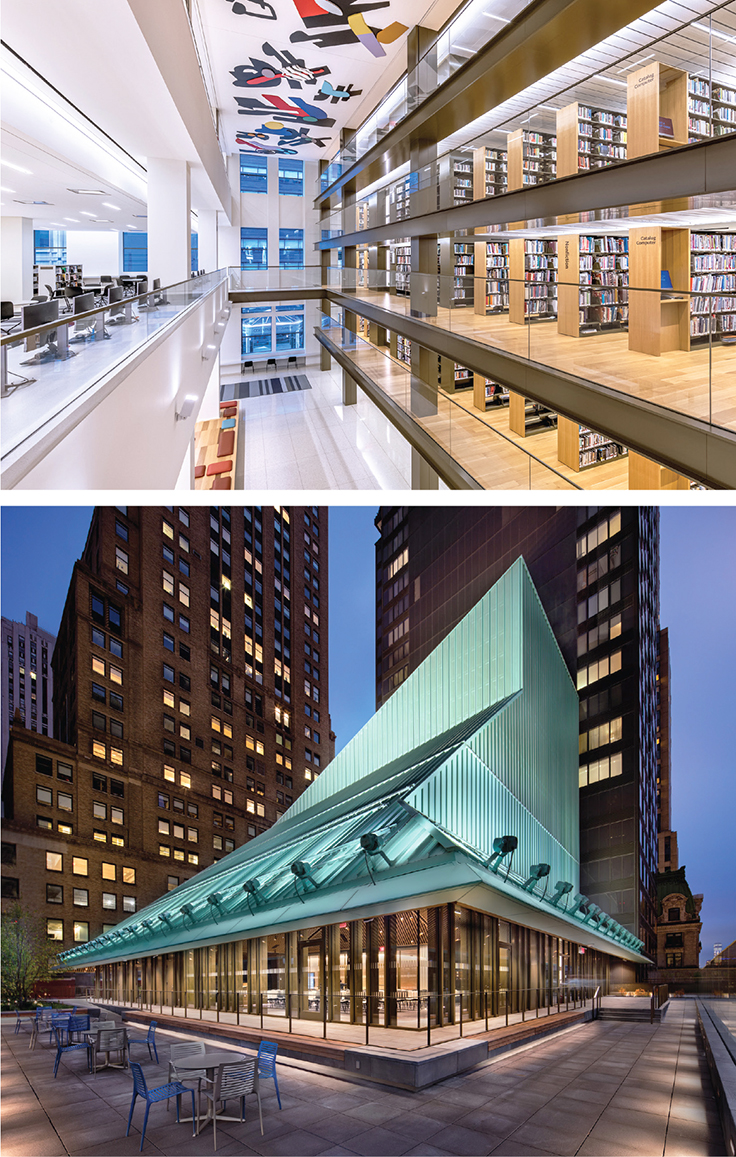A Fresh Start at NYPL | Year in Architecture 2021
The Stavros Niarchos Foundation Library, once NYPL’s busy and bedraggled Mid-Manhattan branch, gets an ambitious upgrade.
The Stavros Niarchos Foundation Library, once NYPL’s busy and bedraggled Mid-Manhattan branch, gets an ambitious upgrade
When your older sibling is the famous, lion-flanked Stephen A. Schwarzman Building of the New York Public Library (NYPL), that can be a hard act to follow. For years, while the high-profile historic building got most of the glory, NYPL’s Mid-Manhattan branch across Fifth Avenue got most of the traffic—and resulting wear and tear—holding the heavily used Marron Family Circulating Collections rather than historic and research-oriented offerings.
Now renamed the Stavros Niarchos Foundation Library (SNFL), the branch has been not just spruced up but completely rethought by Dutch architect Francine Houben of Mecanoo architects with New York-based Beyer Blinder Belle. The $200 million renovation, managed by Tishman Construction, was partially funded by a $55 million grant from the Stavros Niarchos Foundation.
The new 180,000-square-foot library offers 26,000 square feet of enticing kids’ and teen spaces on the lowest level—which features too much natural light to call it a basement—something the old Mid-Manhattan never had. The two are cleverly separated by flexible program space that can be used for either group, and a professional-standard recording studio was already attracting attention despite the pandemic restrictions still in play when LJ toured the space shortly after the June 1 ribbon cutting. A team of teen advisors, whose snapshots were displayed, stuck with the staff through the temporary relocation and played a significant role in the space design, according to Billy Parrott, associate director of SNFL.
Progressing upward, the main lobby level is set up for clean and simple efficiency, allowing visitors to pick up holds, drop off returns, and flow through the high-volume space (the branch sees more than 1.7 million visits a year and circulates 2 million items annually) from one entrance to a separate exit for a seamless customer experience with minimal roadblocks.
 |
|
“THE BEST VIEW IN THE CITY” The Long Room (top) looks on five floors of stacks and art by Hayal Pozanti; the rooftop “wizard hat” (bottom) houses event space surrounded by a terrace. CREDITS: Mecanoo New York, Beyer Blinder Belle, architects; top photo ©2021 Max Touhey, bottom photo by John Bertelstone |
Just how many higher floors there are depends on where you stand: Lower ceilings in the five floors of Long Room stacks are cosy without feeling cramped thanks to the adjacent second floor atrium, and allow the library to store more volumes—the collection holds 400,000 books and other materials on-site—while still keeping good sightlines and freeing up space for people. “If you’re a book lover, it’s the absolute best view in all of New York City,” says Parrott.
Meanwhile, the human-centered floors have higher ceilings to create a feeling of spaciousness. Their 44,000 square feet holds double the number of seats available pre-renovation, plus multiple reservable study and meeting rooms, the 20,000-square-foot Pasculano Learning Center for adults, the 21,000-square-foot Thomas Yoseloff Business Center, computer terminals, and other staples of public library life.
Design-wise, elements from the Schwarzman Building across the street have been intentionally reinterpreted, but in such a modern spirit that the non-architects among us are more likely to notice the originality than the homage. Art on the ceiling of the Long Room by artist Hayal Pozanti is meant to recall the famous Rose Reading Room, as are the permanent installation of a large, mid-century modern table and the mid-century modern–style wooden chairs that were custom designed by Thos. Moser for the space.
But it’s the top level that is, literally, the crowning glory: A roof garden offers a welcome green respite above the busy pavements of midtown. Even when the floor and on-site café were not yet open to the public, the space attracted staff to enjoy the fresh air and views on their breaks. Inside, magnificent large glassed-in event spaces with peaked ceilings will showcase library programs and serve as event venues, revenue generators, and worthy modern counterpoints to the historic gathering spaces across the street.
After initially opening up to the fourth floor for limited browsing and by-appointment computer use, at press time the whole building had opened to masked patrons, and programs were being gradually reinstituted. Sums up Parrott, “The design considerations throughout SNFL help to facilitate the community-building and life-changing work we do every day.”
RELATED
ALREADY A SUBSCRIBER? LOG IN
We are currently offering this content for free. Sign up now to activate your personal profile, where you can save articles for future viewing









Add Comment :-
Comment Policy:
Comment should not be empty !!!